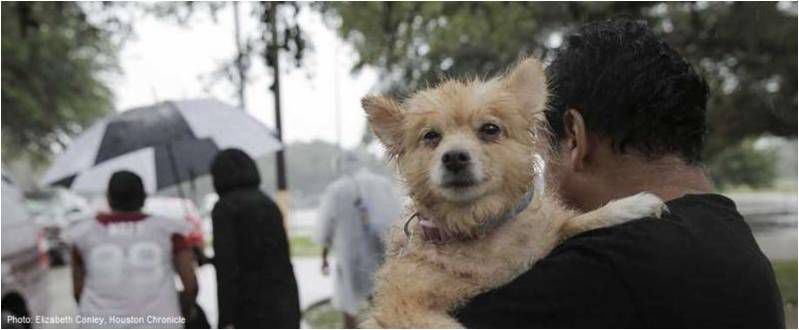In light of the natural disaster unfolding in Texas: Do you have a plan should a disaster hit our area?
Our hearts go out to all the people and animals affected by the recent flooding around Houston. It reminds us to think about our preparedness should a natural disaster or other emergency hit close to home. We hope to never have to implement an emergency plan, but it is something every pet owner should have prepared. Here are some tips to consider when planning for your family pets.
If you need to evacuate or are under evacuation orders, bring your pets with you. If it is unsafe for you to be in your home, it is unsafe for your pets. If you need to evacuate your house, leave a note for rescue teams that people/pets are not in your home. If you have a sticker on your door that indicated pets are inside your home, write on the sticker that you have evacuated.
Make a plan for evacuation that includes adequate supplies to take along. Generally, taking enough supplies for one week is recommended. A proportional number of carriers, crates and leashes for each pet should be available. Determine a place to go if you should be evacuated. A safe place may mean a pet-friendly hotel, a friend or family member’s residence, or in some cases, a shelter.
The following are suggestions of what may help your family be prepared in an emergency or disaster situation. A disaster kit may include the following:
Vet records, including current vaccinations and medical conditions as well as daily medications and contact information for you and another emergency contactAt least a two-week supply of your pet’s medicationsMicrochip information (make sure it is current by contacting the microchip company directly)Food in an airtight, waterproof container, or cans with a pop open top. Bring at least a one-week’s supply for each pet. Make sure dry food is changed monthly to ensure freshness, or a new unopened bag with a late expiration dateOne-week’s worth of clean water in gallons or bottlesDishes for food and waterCrates and/or carriers with the animal’s identification informationLeash/harness or collar for each animalLitter and a litter box or cardboard boxLitter scoop and plastic bags (for litter box lining)Towels and blanketsPuppy pads (for crate lining)FlashlightToys/ treats and other comfort itemsPhotos of your pet and photographs of you with your petPaper towelsDish soapHand sanitizer
Formulating a plan and a disaster kit for your pets will give you peace of mind should a natural disaster affect our area, and you will be ready to take action during an otherwise unnerving situation!




